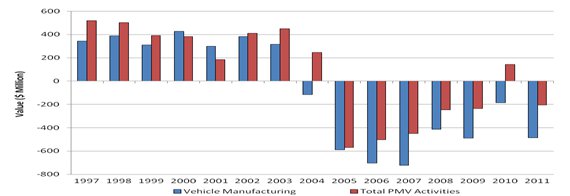There’s an old saying that you can tell the future by the shadows thrown by current events. The leading edge of a shadow is falling over Elizabeth and the local GMH plant in South Australia.
Holden employs about 2,500 at the Elizabeth plant and it’s estimated that those salaries support 10,000 people out of a total population of 83,000 residents in and around the City of Playford. According to the automotive ‘multiplier effect’ every Holden worker creates four to six jobs in South Australia along the supply and retail chain.
This is a story about the future of the automotive industry in South Australia and specifically Elizabeth. The knock-on effects of GMH leaving South Australia would have catastrophic knock-on effects for the local economy and especially for older workers.
Advertisement
Elizabeth is a short drive 20 minutes north of Adelaide’s CBD, where over the last 20 years, 10,000 people have lost their jobs and one third of working aged population are on Centrelink benefits. Youth unemployment is currently around 30 per cent.
Yet it was not always so. In the 1950s, Elizabeth began in optimism under Premier Tom Playford as a satellite city to house semi skilled U.K. migrants, many of who worked at GMH. Some of their sons and daughters still work there. They lived in government supported Housing Trust homes - the type I played in as a kid.
By 1960, Elizabeth was the second largest town in South Australia. The kids went to local schools, the government planted trees, and even built English-styled pubs. But from the early 1970s, the dream began to go sour. The economy turned down and unemployment rose.
Key Automotive Statistics 2011
Local Vehicle Manufacturers’ Profit Performance (Innovation, Industry, Science & Research)

The Commonwealth Government and the S.A. and Victorian Governments recently bought GMH’s goodwill over the next ten years with a $275 million injection to produce two new car lines until 2022. This gave the industry and Elizabeth especially, vital breathing space.
Advertisement
If GMH is planning to stay in Australia, over the next four or five years we’ll see more workers at the Elizabeth plant trained in high-end engineering and design skills in complex materials, lightweight metals, heat treatment of steel and complex electronics. The next generation of cars will use different materials and drive systems from what we use now. A failure to upgrade technology at the plant is a clear signal that GMH will pull out.
The $275 million ‘wages subsidy’ was a carrot to save jobs at GMH’s Elizabeth and Melbourne plants. The Commonwealth and state governments know it and GMH know it too. Premier Jay Weatherill flagged that the S.A. government was considering topping up monies to GMH but that was before BHP withdrew its support from the Olympic mine expansion, effectively knocking out the budget windfall of 10,000 jobs and $5 billion of potential revenue over ten years.
GM Holden managing director Mike Devereux said, “If you removed the co-investment, we (GMH) would be figuring out the most humane way to close this plant.”
Devereux said he was confident there was a “path forward” for the Australian operations, which now produces the Commodore based on an Australian-designed vehicle platform. The company’s Cruze four-cylinder car is a fully global platform manufactured in Adelaide and six other countries.
John Button, the former Minister for Industry and Commerce under the Hawke Government, who dropped the tariffs on the automotive industry in the 1980s, would be rolling over in his grave at the thought the Australian taxpayer was subsidizing vehicle manufacturers. The whole idea was to get them to compete.
Nicholas Gruen, CEO of Lateral Economics, has been involved in car industry policy from various different positions since his involvement in developing the Button Car Plan as Advisor to Senator John Button in 1984. Gruen said it’s about time that a definitive decision was made on where the sector should be headed.
“Global downturns are the fault lines around which our automotive industry has always reinvented itself. In theory, managers should restructure their businesses and businesses should change hands whenever it improves productivity. Alas human nature intervenes. Corporate dreams are dreamt and restructuring is delayed…until the alternative is collapse,” he said in the Technology Spectator recently.
The main problem for the automakers is that buyers are buying smaller and cheaper imported cars. This has forced the local manufacturers to continue the cycle of cutting factory output and jobs to match the lower demand for their vehicles.
The ‘wages subsidy’ has given GMH workers, ten years to retrain or find work in an allied field, because on current sales trends, GMH won’t be in Australia in 2022.
The GMH workforce at Elizabeth is well educated and well trained. Not withstanding the insulting tabloid portrayal of some ‘down and out’ families in Elizabeth and surrounds, the majority of people are hard working, educated to years 11 or 12 and keen to pursue apprenticeships and trades.
The real question is whether Holden will upgrade its facilities and honour the ten-year time frame. Mitsubishi at Tonsley Park in Adelaide was happy to take government handouts but knew that the writing was on the wall in 2008 when it closed down throwing 1000 workers on to the dole. The workers at Elizabeth deserve better than that.
There are strong rumors that Ford will withdraw from Australia in 2016 even though it has invested $103 million in its Melbourne and Geelong operations. The Government kicked in another $34 million. Fords Falcon sales fell 36 per cent in 2011.
Unless Ford, GMH and Toyota find new buyers or their vehicles become wildly popular, within 5-10 years the remnants of Australia’s car manufacturing industry and associated parts makers, will have gone. That would be a disaster for Elizabeth and South Australia.